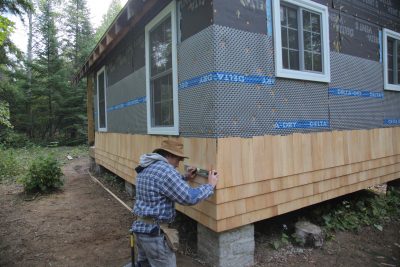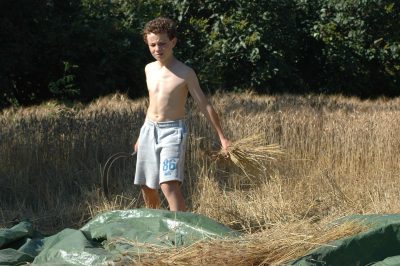In October 1986, I cut through a tumbledown wire fence and drove my 18 year-old pickup truck onto the vacant rural property I’d just spent my life savings to buy. I was a 23 year-old dreamer back then, with a passion to live by my own hands in the country. I’ll always be grateful that my wife, Mary, and I and the 5 kids that have come along since are still living the modern homestead dream and thriving on that same property. We live in a house we built with our hands, we enjoy food, fuel and beauty that comes from our land, and we’re now blessed to see a second generation setting up a self-reliant homestead of their own on our family acreage. But I also have to admit that few other dreamers I’ve seen manage to succeed with their homestead ambitions. It’s sad to see, and a lack of practical know-how is never the primary cause of trouble, either. More often than not, failure is caused by something else.

Modern homesteading is what I’ve been doing for 30 years, and most practical people I know are at least a little curious about what this is all about. I haven’t been an employee of anyone since 1989, my wife doesn’t work outside the homestead, and I don’t have to leave the property for work. Over the years I’ve seen more than a few people attempt to succeed at modern homesteading, but most fail. The reality is that when homestead dreams die it’s usually because of starvation. The dreams I see die (or more commonly never even get born properly) are casualties of nothing more fancy than the failure to get enough of the right kind of work done in a day. Notice I didn’t say anything about working hard. You can work hard (I know I have to), but if it’s not work that puts food on the table, fuel in the stove, water in the sink or money in the bank, it’s probably a waste of time. As bills pile up, gardens don’t get planted, wood piles never get built, and roofs continue to leak, enthusiasm wanes. And the worst of it is, the cause of these problems often goes unrecognized until passion is cold, relationships frazzled and finances exhausted. Although I didn’t realize it at first, I know now that the ability to work productively outside of a traditional job structure is the most important homesteading skill of all. It’s like the difference between free-range chickens and factory chickens. Here’s what I mean . . .
Free-range birds scratch the earth and feast on bugs and grass and wild seeds in addition to food supplied by the farmer. Factory chickens, on the other hand, focus on laying eggs 24/7, never enjoying the challenges, risks and rewards of the varied and riskier life out in the open. So what kind of chicken would you rather be? Mastering the self-reliant homesteading life of a “free range chicken” depends on putting into practice the 6 specific homesteading habits I’ll tell you about here. Make these part of your life and the satisfaction of self-reliant living comes one big step closer.
How to Work Habit#1: Dream, Set Goals & Monitor Them

A homesteader without goals is like a ship without a rudder. You may be sailing, but you won’t end up where you want to go. So what kind of lifestyle do you want from your homestead? For us it comes down to three main guiding principles:
1. Earn all family income without leaving the property.
2. Raise our kids side-by-side with us, with both Mary and I home all the time.
3. Produce as much of our basic needs as directly as possible given the time and attention we can afford to invest.
At first we didn’t always succeed with these principles, but we’ve been homesteading long enough now that we do. Filter all decisions and actions through your list of guiding homestead principles and let them be the rudder that steers you. The need for setting goals is much greater when you don’t have a conventional job because the schedule created by the boss behind your job helps guide you. When you’re the boss, you need to take on all the boss’s responsibilities.
How to Work Habit#2: Live With a Disciplined Schedule & Intentional Rest
No boss, no outside schedules, no imposed deadlines. These are some of the attractions of self-reliant living, but they’re also the features most likely to make you fail. No boss means your success depends entirely on how well you decide what must get done. No schedule means you thrive only if you fill your day with activities that contribute to the bottom line. No deadlines means your survival hinges on how productive you are. Self-reliance is really about self-responsibility.
So, why bother with self-reliance if it doesn’t get you out of work? The satisfaction of gaining directly from your own efforts is one reason why. This immediate connection between productivity and benefit is one of the things I like best about self-reliant rural living. This and the wide variety of different homesteading tasks done with family and friends means that work becomes more like serious play. I’ve worked for wages and I’ve worked for myself on the land and they are two entirely different experiences.
So what does disciplined, day-to-day living look like on a modern homestead? It starts with a schedule that includes at least 8 hours of real work each day. If the self reliant life really is for you, you’ll probably want to work longer than this each day because work becomes a kind of play – at least most of the time. But all work and no real play isn’t good either. The older I get the more I value this particular bit of ancient wisdom about the weekly rhythm of work: “Six days you shall labor and do all your work, but the seventh day is a sabbath.” Notice the details here: six days of work, one day of rest. It’s a very good pattern indeed.
How to Work Habit#3: Do The Right Work in the Right Way

Never before have ordinary people had such easy access to the information that makes for a thriving homestead life. The internet is the reason why. You can see and learn to do any task imaginable online, and that’s why I consider the internet an essential modern homesteading tool. You’ll need many more tools, of course, but the internet is crucial. I’m sure our homestead life would never has succeeded without it.
All this said, even essential how-to information is pretty much a waste of time if it’s not applied to tasks that matter the most. That’s why it’s so important to prioritize where you invest your efforts by making and using lists. During the evening, write down everything that needs doing the next day based on your goals for the following week and month. Don’t let personal preferences for certain jobs postpone tackling high priority items, and don’t worry about those things on the list you aren’t doing yet. Just get to them later.
But busyness alone isn’t enough for successful self-reliance, and that’s sometimes the case when I see newbies struggling with inadequate tools and methods for the job. It sets the stage for the slow decay and decline of homesteading dreams. You certainly won’t be able to buy professional grade tools and gear right away, but work towards it. Doing work in the right way usually means doing it the way professionals are equipped, not hobbiests. The good news is that pro-grade tools are much less expensive than they were decades ago.
Renting equipment makes sense, but not unless you happen to live close to a rental outlet. Better yet, try and hire your neighbour with a tractor to till your garden, trade work for the chance to borrow a wood splitter, or barter labour for a side of beef until you can build the collection of equipment that makes sense for you to own. Aim to become not just a jack of all trades, but a well-equipped, self-reliant master of most. It’s an achievable, long-term goal that sets the stage for long-term prosperity.
How to Work Habit#4: Carry a Pocket Pad

Pound for pound, my pocket pad and pen are the most important physical tools I own. They’re always with me to catch the little thoughts that waft through my head during the day: “Buy 5 lbs of four inch deck screws”; “Call Rob D. about shingle order”; “Take photo of spiders in pasture for blog”; “Harvest garlic.” I have a pretty good memory, but why tax it unnecessarily with little things? More important than this, why waste a trip into town by forgetting some small but vital item to buy? No homesteader who expects success can waste unnecessary trips into town.
I began using pocket pads in 1987, but when electronic organizers came out I used them for more than 10 years. I’m back to an actual paper pad now and find it works better than electronics in lots of ways. Whether you use a smart phone or paper pad, recording important details during each work day is vital because it boosts efficiency so much. And trust me, efficiency is the difference between success and failure on any modern homestead. Most people fail at self-reliant living for the simple reason that they don’t get enough useful work done each day to make ends meet. This is an easy pitfall to fall into when you don’t have the structure of a regular job to guide you.
How to Work Habit #5: Move Quickly
The most spectacular homesteading failures I’ve seen all involve people who talk a lot and move slowly. If you do this in a regular job, you’ll either top out at a junior level or you’ll get fired. What you might not realize is that your homestead can fire you, too. When bills catch up and the garden doesn’t get tilled in time and your wood pile is too small come November, the homestead will hand you a pink slip and it’s more shocking than the regular kind. No government ever paid unemployment benefits to anyone after getting fired from their homestead.
Simply moving quickly as you walk around and perform tasks can boost your self-reliance output by 20% or 30%. It’s not about running around frantically, but rather about being deliberate, focussed and efficient. Once this becomes a habit, productive work isn’t something you even think about any more. It becomes the new normal and you thrive.
How to Work Habit#6: Avoid Distractions
An old timer I know tells a story of how things used to be in the countryside where he grew up during the 1930s: “We were dirt poor back then, but everyone managed to keep their barns repaired and houses painted. Nowadays people sit inside watching satellite TV or YouTube while their places fall apart around their ears.”
Social media, television, computer games, online videos – all these things can be addictive and costly to self-reliance because they create a leisure mentality. And while this certainly isn’t true for everyone and every place, the leisure mentality is a big enemy to successful, self-reliant living.
No responsible boss would allow you to watch daytime television, play games during the work day or socialize online while you’re on the clock, and it’s not just because he wants to spoil your day. The fact is that unless you’re financially independent, we all need to get things done, regardless of whether we work and live entirely in the money system or on a homestead that relies on money for just 30% of its needs.
As I mentioned before, the internet is essential to our particular self-reliant homestead, both for information and to earn the money we need. Just understand that the modern world is full of distractions that turn people into spectators and consumers rather than participants and producers. You’re free to make use of these distractions during the work day, but they could cost you your dreams of a self-reliant, hands-on life. They probably will. All of us are free to choose our actions, but none of us are free to choose the consequences.
Learning the practical nuts and bolts of hands-on living is vital, but not as important as learning the one, main skill on which all others depend – the ability to work efficiently and consistently, achieving goals that matter. I want to see more homesteaders succeed, and working well is the most important part of making successful self reliance happen.
A Word About Money
I don’t know anyone who wants to live completely without money, and that’s why finances are an important part of any homestead. Perhaps even the most important part. When we began in the late 1980s, our plan was to run a pick-your-own berry farm and to build furniture for sale. That began to change when my interest in writing led to my first published article in 1988. Twenty six years later most of the money work I do now involves creating articles, blogs and videos about woodworking, construction and power tools, working from the shop and studio I built on our property. We still grow berries and work with wood, but it’s usually for our own use, with cash coming in mostly from digital sources.
What will you do to make ends meet on your homestead? Whatever it is, make it an extension of your interests and aptitudes, and make sure the internet is part of the mix. There’s no business that the internet can’t enhance, and there are few rural areas that have the population to support thriving small businesses without a little digital help.
Farmer friends of mine are using the internet to market high-quality beef to urban markets. A young mother I know makes exquisite chocolates in the commercial-grade kitchen she set up in her country home, using the internet to sell her unique creations across the continent. I work with digital assistants, artists, graphic designers and editors across North America. All of them can – and often do – work wherever they please. The challenge of earning an income on a rural homestead is all about dealing with remote geography, and the internet goes a long way to remove geography from the equation. A woman I know uses Facebook extensively to let local people know about produce she has for sale, baking that has just come out of the oven, and courses she offers on herb gardening. Like I said, the internet is the homesteaders best friend, especially when it comes to earning money.
A Day In the Life . . .
Our modern homestead household includes 5 kids so far, so there’s always lots to do. My day starts between 7 and 7:30am, either working on the digital side of my homestead life or the practical side of hands-on jobs like fixing machinery, tending cattle and fences, working in the garden and tackling building projects around the property. My wife, Mary, is a full-time homestead homemaker so she has lunch ready for the family at 12 noon, then it’s back to work from 1pm until 6pm before supper.
I’ve been working on a welding project lately using black iron pipes to build a railing and gate. Later today I’ll replace the front brake pads and rotors on one of our vehicles. Later in the season, when the warm weather arrives, it will be quite a treat to hear whippoorwills sing while a full moon is rising through the trees. Before winter sets again after next fall, I’ll put the garden to bed, pick some apples for a pie bee that Mary will do with friends of hers, extend the watering system on our cattle pasture, and work on building online courses that I sell to people around the world.
This is our pattern of modern homestead work for 6 days a week, with no work beyond the essentials on Sundays. One thing you might not realize is how the variety of a homestead work week makes it so much nicer than paid work, at least for me. I look forward to Mondays just as much as Fridays, and I’m excited to get out of bed each day. I don’t travel for work unless I want to, we heat with wood and we make, reuse and repair a lot of what we need. This isn’t the life for everyone, but it certainly is for us. And from what I see and hear, I think it’s just the thing for other people, too.